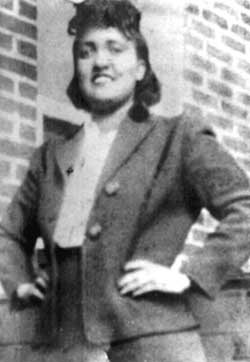She’s here. She’s in the room. I’ve not noticed her before — not in previous years — but every now and then her presence is unmistakable.
I am sitting in a lecture theatre in St Andrews University in Scotland, attending the 16th Meeting of the European Study Group on the Molecular Biology of Picornaviruses, or Europic, as it is more conveniently known. Despite its Euro-centric name, the conference attracts participants from all over the world and about 200 of us have gathered here to tell one another about our research.
Picornaviruses are a large family of viral miscreants that includes poliovirus, human rhinovirus (the major cause of the common cold), hepatitis A virus and my own favourite, foot-and-mouth disease virus. I like viruses and I like Europic — I’ve been coming to the conference since 1991. A large part of its appeal is the conviviality of the participants, many of whom I greet like old friends, even though our only contact is a few days together every other year.
But I also enjoy the breadth of the science. We come to scrutinise the life cycles of these tiny molecular pathogens, and the sickness and death that ensues when they gain entry to the cells of the body to initiate an infection.
All aspects are covered on a scale that ranges from the atomic to the planetary. We dissect the atomic details of how the virus molecules interact with host cell proteins, review the reorganisation of the cell interior that occurs as the viruses commandeer its protein manufacturing centres, discuss how the sickened host marshals its defences against the invader and debate the merits of ongoing plans to eradicate the scourge of polio from the face of the earth.
Though my own focus is usually fixed at the atomic and molecular end of the spectrum of investigation, over the years I have gradually absorbed the cellular, organismal and epidemiological studies that are helping to flesh out a complete picture of virus infection.
So I try to stay tuned in all the talks. But this year there has been something different about the conference. It hasn’t happened in every talk but from time to time, after the same visual or audible cue, I am suddenly aware that there is someone new at Europic, someone I hadn’t noticed before. Her name is Henrietta Lacks.
The cue is in the mention of her cells, which are known by the four letter diminutive, HeLa — not a name of her choosing. HeLa cells have been growing — multiplying in numbers — in laboratories all over the world since they were taken from Henrietta in Johns Hopkins Hospital in Baltimore back in 1951. She died in great pain shortly afterwards leaving a young family of five children and never knew that she changed the world. She never knew that the biopsy taken from her cervical tumour would establish the first immortal culture of human cells.

I know this because I read Rebecca Skloot’s The Immortal Life of Henrietta Lacks over the summer. This fascinating book gives a forensic and moving account of the tremendous impact that HeLa cells have had on scientific research and the wretched wound of anguish that science inflicted on her family. I don’t intend to give a detailed review since that ground has been well convered by Mark Henderson and Ed Yong among others, but it’s a fantastic read. Skloot has a firm grip on the research into cancer, virology and cell biology that was so stimulated by the establishment of a human cell-line that could be grown in bottles in the laboratory. But more importantly, the book brings Henrietta to fleshy life again by telling the story of her children’s struggles to come to terms with their mother’s living legacy. They knew nothing of the biopsy and only discovered many years later that her cells were still alive; they never benefitted from the millions that were made by selling HeLa cells to researchers.
The book recovers a story that was nearly erased from history because none of the scientists who worked to establish the HeLa cell line had any contact with Henrietta’s family; and few of those who used her cells in their research considered their origin.
It is a story worth telling — not just because it serves to remind scientists of the value of retaining some sense of the people they use, and the people they might hope to serve. Skloot’s journalistic eye (and tenacious investigation) captures a wealth of detail in uncovering the drama of the Lacks family. Their human story is more gripping than the scientific one, though never more so than when the two intersect. One of the most poignant episodes in the book is when cell biologist Christoph Lengauer, who has been contacted by Skloot, invites two of Henrietta’s children to look into his microscope to see their mother’s cells for the very first time, fifty years after she died.
I’ve seen HeLa cells myself in the microscope but I never thought much about them beyond counting their number to check that my cultures were thriving. I grew HeLa back in the mid-nineties, litres at a time, to infect with poliovirus. This provided milligrams of purified virus particles that I could use to examine how poliovirus shifted and shimmied to trick its way into a susceptible cell. I didn’t know where the cells came from — sorry, who they came from. I was focused on the science, thinking only of how to get my experiments to work. I had quickly swallowed the pseudonym — Helen Lane — that had been put out by the scientists at Johns Hopkins to ‘protect’ Henrietta’s anonymity and never paused to question the circumstances of their origin.
But I have now. And this year at Europic whenever I hear “we infected HeLa cells” or “here you can see the effect in HeLa” or noticed that four-letter label on a slide, the image of Henrietta floats into my mind’s eye. Hands on hips, smiling, she is here, watching us, following the proceedings.
In reality, of course, she’s not here and she’s not aware of our discussions. But in the darkened conference hall I still feel the need to nod acknowledgement and whisper “Thanks.”






"they never benefitted from the millions that were made by selling HeLa cells to researchers."
Will they receive any proceeds from the book?
Will they receive any proceeds from the book?
Yes, I think they will.
Very, very nice Stephen! I finally read the book in August too and was floored.
Oh, nice – the link didn’t make it. Here it is (well, maybe):
http://rebeccaskloot.com/book-special-features/henrietta-lacks-foundation/
I too know these cells well, but the Lady is not always the friend of the researcher, having a tendency to gatecrash others parties. There is a fascinating article here in which a moleular forensics analysis revealed that at least 40 regularly used cell lines have been contaminated by HeLa cells.
Steffi’s right Jacqueline (I fixed your link, Steffi) – a portion of the proceeds of the book will go to a foundation that the author has set up to provide support for education and health care for the Lacks family.
I’m not sure how well non-fiction popular science books sell but this one has had a lot of publicity (deservedly so) so I hope it’s doing well. A quick look on Amazon shows it to be #61 in their sales rank which is pretty good!
@Stephen – yes that issue of contamination is also covered in the book. Thanks for the link to that PNAS article.
Nice post, Stephen. Like many others, I had heard the "Helen Lane" description of the cells in my scientific youth when people talked about them. Found out about the other name years later. I think I first read the full Henrietta Lacks story on David Kroll’s old Terra Sigillata blog, as he has covered the story (and Skloot’s book) quite a lot (e.g. here). Haven’t heard anything other than raves for the book, so I must remember to ask for it for Christmas.
Re. Stephen Moss’s comment, the way I first heard this story was in connection with President Nixon’s famous early 70s "War on Cancer". This programme gave a lot of attention to deriving cancer cell lines from different tissue-specific tumours – nearly all of which later turned out to be HeLa cells, presumably via contamination and "out-competition".
Another recent reader of the book here. It is a curious mixture of a book, but it seems that every other page raises huge issues – race, poverty, social justice, ethics and the like. We will have a Mill Hill Essay about the book – just editing that now.
A testament to the way the book holds your attention – one day last week I was reading it on the tube and missed my stop!
Thanks for those links Austin. The book is a great read – very multi-layered (or, as Frank puts it, a ‘curious mixture’).
It is part straight science, part straight history and part the story of Skloot’s interactions with the Lacks family, especially her eldest surviving daughter, Deborah (who has since died). Hilary Mantel’s review in the Guardian suggested that Skloot had inserted herself too much into the story but I didn’t find that a problem – particularly since her many meetings with the family were important for bringing out different aspects of the story.
Given that its largely set in Baltimore and presents a vivid characterisation of the black community there — warts and all (some of Henrietta’s children/grandchildren have done time in prison), there were shades of The Wire for me — in a good way!
Sorry you missed your stop Frank, but I can understand why.
warts and all
Ha! See here for more.
Ha Frank – that link is a great find. My comment was entirely unconscious. Indeed, although I knew that Henrietta Lacks’ cervical cancer was more than likely due to a papillomavirus infection, I didn’t know that these viruses are also the general cause of warts.
Just in case anyone panics at this information, only some strains of papillomavirus are strongly linked with cervical cancer (mainly type 16 but also types 18, 31 and 45). The ones that cause warts and verrucas, while bothersome, are much less dangerous.
Thanks Stephen, I’m another fan of the book. The German translation was published this week.
Cheers Martin – I gathered from Twitter that Rebecca Skloot was in Germany this week – she’s doing sterling promotional work!
Lovely post, Stephen. I’ve also read the book – I reviewed it for BBC Focus – and thought it marvellous.
It is a wonderful story. I’ve heard/read so many interviews with the author, though, that I’m not sure the book would hold many surprises. I wonder if the powerful human story here would make this good material for a movie treatment.
Spot on Henry.
Matt, Rebecca Skloot is ahead of you. According to her twitter bio, the book is "soon to be an Oprah/Alan Ball/HBO film".
So there’s another connection with The Wire, which was also made by HBO…
Actually, now that Frank said it: for me the book was a nice glimpse into the world of cell biology and – maybe more so – a fascinating account of an important part of US history. With apologies for that sounding like a book cover text, I would recommend it for both of those aspects!
Sorry Steffi – only catching up after a frenetic day yesterday. The cell biology is an interesting part of the book but, as you say, it’s really a minor component of a book that touches on many issues. The main story is about the neglect of Henrietta’s surviving family but there are also important lessons about how scientists communicate with the public, and about scientific ethics and the rights people have over their tissue samples (almost none it would appear).